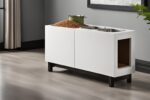Creating a DIY Health Tracker for Monitoring Your Dog
Are you concerned about your dog’s wellness? With the advancement of pet care technology, it’s now easier than ever to keep track of your furry friend’s health and activity levels. In this article, we’ll show you how to create a DIY health tracker for your dog, allowing you to monitor their well-being with precision and ease.
By following our step-by-step guide and using readily available materials, you can assemble a custom pet monitoring robot that connects to an app on your smartphone. This innovative device features an onboard camera for live streaming, allowing you to check in on your dog at any time. Additionally, it includes an add-on treat bowl for remote rewards, ensuring that your pet feels loved even when you’re not at home.
One of the key advantages of this DIY health tracker is its customization options. Using digitally fabricated parts, you can create a unique device tailored to your pet’s needs. With a Raspberry Pi and Arduino, you’ll have complete control over the robot’s movements, allowing you to monitor your dog’s activity and health from anywhere.
Join us on this exciting journey as we dive into the world of DIY pet care technology and empower you to take charge of your dog’s wellness. Let’s get started on creating a DIY health tracker that will revolutionize the way you care for your furry companion!
Step 1: Overview of the Design
When creating your very own DIY dog health tracker, it is important to understand the overall design of the project. The tracker takes the form of a pet monitoring robot that can be controlled through a user-friendly app. This app allows pet owners to connect remotely and keep a close eye on their furry friends.
One of the key features of the DIY dog health tracker is an onboard camera. This camera provides a live streaming video feed of your pet, allowing you to check in on them at any time. Whether you are at work, out running errands, or even on vacation, you can always keep an eye on your beloved pet.
In addition to the camera, the DIY dog health tracker also includes an add-on treat bowl. This treat bowl can be controlled remotely through the app, giving you the ability to reward your pet even when you’re not physically present. It’s a great way to reinforce good behavior and keep your pet happy and engaged.
Furthermore, the tracker features digitally fabricated parts that can be customized to meet your unique preferences. Using software like Fusion 360, you can design and modify parts such as stepper holders, vision system mounts, and chassis reinforcement. These parts are then brought to life using a 3D printer and laser cutter, giving you complete control over the aesthetic and functionality of your DIY dog health tracker.
Overall, the design of the DIY dog health tracker puts emphasis on app control, live streaming capabilities, treat dispensing, and customization options. It’s a perfect project for pet owners who want to harness the power of technology to enhance their pet’s well-being.
Benefits of DIY Dog Health Tracker Design
“The DIY dog health tracker design combines advanced technology with the personal touch.”
– Pet Care Innovations, Smart Pet Solutions
| Design Features | Benefits |
|---|---|
| App Control | Easily monitor and interact with your pet from anywhere using your smartphone or tablet. |
| Onboard Camera | Stay connected to your pet through live streaming video, ensuring their safety and well-being. |
| Add-On Treat Bowl | Reward your pet remotely with treats, promoting positive behavior even when you’re away. |
| Customization Options | Create a truly unique pet tracker by customizing parts according to your style and requirements. |
Step 2: Materials Needed
To create a DIY dog health tracker, you will need the following materials:
- Arduino Uno
- Raspberry Pi
- CNC shield
- A4988 stepper motor drivers
- Picamera
- Ultrasonic distance sensor
- 11.1v Lipo battery
- NEMA 17 stepper motors
- 5v UBEC
- Wheels
- Castor wheels
- M4 and M3 nuts and bolts
The total cost of the project, excluding the Arduino and Raspberry Pi, is estimated to be around $50. These materials are readily available for purchase and will provide you with all the necessary components to build your DIY dog health tracker.
![]()
Note: The image above showcases a fully assembled DIY dog health tracker with the materials listed.
Step 3: Digitally Fabricated Parts
Creating a DIY dog health tracker involves designing and fabricating custom parts for optimal functionality and personalization. Using advanced technologies like 3D printing and laser cutting, you can create unique components that enhance the construction of your pet monitoring device.
To begin, the parts for your DIY dog health tracker are designed using Fusion 360, a powerful CAD software. This allows you to visualize and customize every aspect of your tracker’s components according to your preferences and requirements.
Once the designs are finalized, the fabrication process begins. 3D printing is utilized to manufacture various parts, including stepper holders, a vision system mount, electronics standoffs, vertical spacers, chassis reinforcement, a treat bowl lid, a treat bowl, a rear stepper mount, and a winding disc.
The 3D printed parts offer precise dimensions, durability, and functionality, enabling seamless integration into your dog health tracker. With Fusion 360 and 3D printing, you have the flexibility to create custom-made parts that perfectly align with your pet’s unique needs.
In addition to 3D printed components, the construction of your DIY dog health tracker involves laser cutting. The laser-cut parts consist of a bottom panel and a top panel, providing structural support and housing for the inner components of your device.
By leveraging laser cutting technology, you can ensure precise and clean cuts, resulting in accurate assembly and a visually appealing final product.
The image above showcases the intricate details and precision that can be achieved through 3D printing and laser cutting in the creation of custom parts for your DIY dog health tracker.
| Digitally Fabricated Parts | Technology Used |
|---|---|
| Stepper holders | 3D printing |
| Vision system mount | 3D printing |
| Electronics standoffs | 3D printing |
| Vertical spacers | 3D printing |
| Chassis reinforcement | 3D printing |
| Treat bowl lid | 3D printing |
| Treat bowl | 3D printing |
| Rear stepper mount | 3D printing |
| Winding disc | 3D printing |
| Bottom panel | Laser cutting |
| Top panel | Laser cutting |
The table above highlights the various digitally fabricated parts that are integral to the construction of your DIY dog health tracker. By utilizing 3D printing and laser cutting technologies, you can create custom-made components that enhance the functionality and aesthetics of your pet monitoring device.
Step 4: Attaching the Stepper Motor
Now that all the 3D printed parts are ready, it’s time to attach the stepper motor to the motor holder. The motor holder is specifically designed to fit the NEMA 17 model, ensuring a secure and stable connection.
Assembly Instructions:
- Take the stepper motor and slide it into the motor holder, aligning the mounting holes.
- Using the provided mounting screws, secure the motor in place by tightening them firmly but not too tight.
- Repeat the same steps for the second stepper motor, ensuring both motors are securely held in their holders.
Properly attaching the stepper motor is crucial for the smooth operation of your DIY dog health tracker. Ensuring a secure and stable connection between the motor and the holder will result in accurate movement and tracking capabilities.
Step 5: Mounting the Steppers to the Bottom Panel
Mounting the stepper motor holders to the bottom panel is a crucial step in assembling your DIY dog health tracker. By securely attaching the stepper motor holders, you ensure the stability and proper functioning of the tracker.
To begin, gather the necessary materials:
- Stepper motor holders
- M4 bolts
- M4 nuts
- Chassis reinforcement strips
- Bottom panel of the DIY dog health tracker
Here’s how to mount the steppers to the bottom panel:
- Place the stepper motor holders on the bottom panel in the desired location and align them accordingly.
- Insert M4 bolts through the holes on the bottom panel, passing through the stepper motor holders.
- Secure the bolts on the other side of the bottom panel with M4 nuts, ensuring a tight fit.
- Before fully tightening the nuts, add chassis reinforcement strips beneath the bottom panel to distribute the load evenly. This helps prevent any potential stress concentration on the acrylic panel.
- Once the chassis reinforcement strips are in place, tighten the M4 nuts firmly to securely attach the stepper motor holders to the bottom panel.
- Finally, pass the wires of the stepper motors through the dedicated slots provided on the bottom panel. This step prevents the wires from getting entangled with the wheels during operation.
By following these steps, you successfully mount the stepper motor holders to the bottom panel of your DIY dog health tracker. This ensures stability and allows for smooth movement during operation.
Step 6: Fitting the Wheels
Now that the acrylic panel of your DIY dog health tracker has sections cut out, it’s time to fit the wheels. These wheels are an essential component that will provide mobility and stability to your pet monitoring robot.
We recommend using wheels with a diameter of 7cm for this project. These wheels come equipped with set screws that allow secure attachment to the 5mm stepper shafts. Ensuring a secure attachment is crucial to prevent any slipping or wobbling while your DIY dog health tracker is in motion.
By fitting the wheels properly, you are completing the foundation of your DIY dog health tracker. This step ensures a sturdy base that will support the robot’s movement as it monitors and tracks your pet’s activity and health.
| Step | Description |
|---|---|
| 1 | Take the wheels and align them with the sections cut out on the acrylic panel. |
| 2 | Place the wheels over the stepper shafts, ensuring a snug fit. |
| 3 | Tighten the set screws using a suitable tool to secure the wheels to the stepper shafts. |
| 4 | Repeat the process for all the wheels to ensure consistent and secure attachment. |
Conclusion
Creating a DIY dog health tracker is an innovative way for pet owners to monitor their pets’ wellness using advanced pet care technology. By following the step-by-step guide and utilizing the recommended materials, you can assemble a pet monitoring robot that can be controlled through a user-friendly app. This DIY dog health tracker offers a range of features, including live streaming, treat dispensing, and customization options, providing a comprehensive solution for tracking your pet’s activity and overall health.
By incorporating technology into pet care, you can ensure that your furry companion’s wellness needs are met effectively. The DIY dog health tracker allows you to stay connected with your pet even when you’re away, providing peace of mind and the ability to address their needs in real-time. Whether you’re monitoring their exercise levels, diet, or overall behavior, this innovative tool empowers pet owners to take an active role in their pet’s well-being.
With the ability to customize the DIY dog health tracker, you can tailor the device to your pet’s specific requirements and preferences. Whether it’s adding extra features or personalizing the design, the customization options allow you to create a pet monitoring tool that perfectly suits your pet’s individual needs. This level of customization ensures that your DIY dog health tracker is not only functional but also uniquely tailored to your pet’s wellness demands.
In conclusion, the DIY dog health tracker revolutionizes the way we monitor our pets’ wellness. This technology-driven approach provides pet owners with a powerful tool for tracking their pet’s activity, health, and behavior. By using this DIY solution, pet owners can ensure that their beloved companions live healthier and happier lives, benefiting from the integration of technology, customization options, and a proactive approach to pet wellness.
FAQ
What is a DIY dog health tracker?
A DIY dog health tracker is a pet monitoring system that allows you to track and monitor your dog’s wellness using innovative pet care technology.
How does a DIY dog health tracker work?
A DIY dog health tracker works by creating a custom pet monitoring robot controlled via an app. It features an onboard camera for live streaming and an add-on treat bowl for remote rewards.
What materials do I need to create a DIY dog health tracker?
You will need materials such as an Arduino Uno, a Raspberry Pi, a CNC shield, A4988 stepper motor drivers, a Picamera, an ultrasonic distance sensor, NEMA 17 stepper motors, wheels, and various nuts and bolts.
Can I customize the DIY dog health tracker?
Yes, you can customize the DIY dog health tracker by using digitally fabricated parts designed using Fusion 360 and then 3D printed or laser cut.
How do I attach the stepper motor to the DIY dog health tracker?
To attach the stepper motor, secure it in the specific motor holder designed for the NEMA 17 model using mounting screws.
How do I mount the stepper motor holders to the DIY dog health tracker’s bottom panel?
The stepper motor holders are mounted to the bottom panel using M4 bolts. Chassis reinforcement strips are added before securing them with nuts to ensure even distribution of the load.
How do I fit the wheels onto the DIY dog health tracker?
The wheels are securely attached to the stepper shafts using set screws, providing a sturdy base for the DIY dog health tracker.
Why should I create a DIY dog health tracker?
Creating a DIY dog health tracker allows you to monitor your pet’s wellness using innovative pet care technology, providing a comprehensive solution for tracking your pet’s activity and health.






